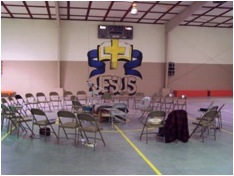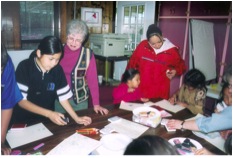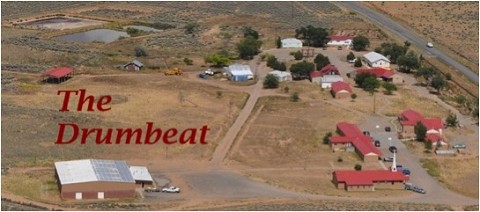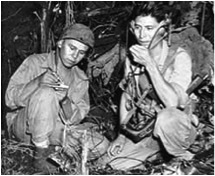Navajo – BIC, NM – Youth

Ministry Description
Your core ministry will be the Mon-Wed, mid-day Bible Camp, for 60+ kids, ages 5–19 yrs. Plan on long,full days. Bring vans because you’ll have to pick up (starting 7:45 AM) many of the kids who attend and return them home (ending about 4:00 PM).
Kids 13+ will be in a group just for teens, studying serious issues they face daily. Kids 12 and under will be divided into groups and rotated through stations for arts & crafts, games, Bible lesson, music & singing, drama/skits, and lunch. We’ll need concurrent studies for 10-20 adults (usually ladies only), with a new craft each day.
Hot and delicious lunches will be a highlight of your Bible Camp. Plan on bringing a couple of good cooks so we can make these lunches remarkable every day, a big job.
 Cap the Bible Camp week with a Family Night on 6-8 PM on Thursday, including supper, for kids and parents. Include games-stories-programs & skits. And lots of laughter!
Cap the Bible Camp week with a Family Night on 6-8 PM on Thursday, including supper, for kids and parents. Include games-stories-programs & skits. And lots of laughter!
Other evenings we’ll support BIC base programs like Open Gym Basketball and Volleyball. During what free time you have available, your team can tackle a few small repair or maintenance projects for the base. Plan on taking time Thursday and Friday to visit new friends, including base staff.
Project Overview
The Navajo Brethren In Christ Mission (BIC), established in 1947, is located 30 minutes south of Bloomfield, in the NW corner of New Mexico, just outside Navajo Nation boundaries. The BIC's goal has always been to build relationships with the Navajo in order to reach out to them with the unconditional love of Jesus.
Our partners at the BIC have worked on site at the BIC mission base since 1999, becoming Base Directors in 2003. They are committed to being Jesus to the people of the surrounding communities. They see people the way Jesus does, meeting their practical needs as well as teaching life skills and Biblical principles.
The Navajo have successfully kept their culture intact, so their perspective is often very different from visiting Anglos. Many Navajo are cautious when interacting with visitors. Advance study about the culture will help to avoid misunderstandings. 
The BIC’s ministries to the Navajo include Nizhoni Christian Academy (K-12), Bible studies and camps, Christmas love gifts to many families, summer team outreaches, the Navajo Craft Shop, the Overcomers residential program for recovering addicts, First Nations Gathering on Sundays, open gym nights, fresh water in volume, a coin-op laundry and coin-op showers, clothing bank, and tire repair center.
People, Culture, and Religion
The Navajo call themselves Dineh, meaning The People. They are related to Apaches, Hopi, and other tribes of the Southwest. Their eventual collision with European cultures was disastrous. Turmoil filled the 19th-century period of Navajo history. As more Anglos settled in the New Mexico and Arizona territories during the early 1860s, the Navajo and Mescalero Apache fought to maintain control of their lands and way of life.

In January of 1863, the Army began to lead bands of Navajo from their traditional lands for the purpose of relocation. Soldiers forced the people to walk 300-400 miles in harsh winter conditions to Fort Sumner on the in eastern New Mexico. The Navajo refer to the journey as the Long Walk. By 1865, more than 8,500 Navajos lived among 500 Mescalero Apache with shortages of food and firewood, contaminated water, and disease. The relocation effort failed.
In 1868, a treaty permitted the surviving Navajo to return to their homeland, now set aside as a reservation. They were joined by thousands who had been hiding out in the hinterlands. The Navajo are one of the few Native groups who managed to retain a significant portion of their lands. They were able to return to farming, sheep herding, and weaving. Many still choose that lifestyle today. Others make silver jewelry, pottery, and rugs.
The Navajo people are tenacious, adaptable, and enduring. Most speak English as well as Navajo. Navajo Marines in the Pacific during World War II helped win the war in their role as C ode Talkers. Using their Native language, they created a code that was never broken by the Japanese.
ode Talkers. Using their Native language, they created a code that was never broken by the Japanese.
Traditional Dineh base their way of life on a belief that the physical and spiritual worlds blend together, and everything on earth is alive and sacred. Traditional Dineh also believe that the Earth People are ordinary mortals, while the Holy People are spiritual beings that cannot be seen. The Holy Ones live in the four sacred mountains in each of the four directions, thus creating the boundaries of Navajo lands. Although many still adhere to their cultural, social, and traditional values, incorporating their spiritual beliefs into daily life, elders often lament that younger generations seem to be abandoning traditional ways.
